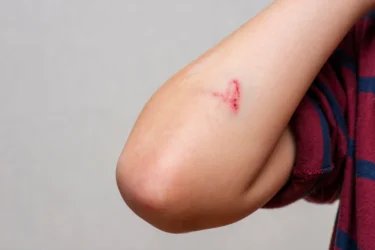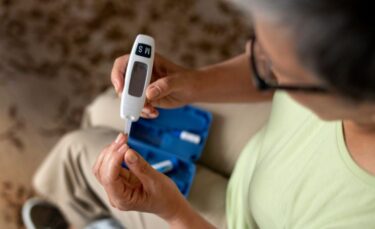Banana Leaf: Uses, Benefits, Side Effects By Dr. Smita Barode
By Dr Smita Barode +2 more

Get,

to manage your symptom
Get your,


4 Cr+ families
benefitted

OTP sent to 9988776655



You’ve successfully subscribed to receive
doctor-approved tips on
Whatsapp

Get ready to feel your best.

Hi There,
Download the PharmEasy App now!!


Register to Avail the Offer
Send OTPBy continuing, you agree with our Privacy Policy and Terms and Conditions

Hi There,
Sign up on PharmEasy now!!
Trusted by 4 crore+ families

OTP sent to 9988776655



You have unlocked 25% off on medicines




Code: NU25

Comments


Leave your comment here
By Dr Smita Barode +2 more
Table of Contents
We have all enjoyed a typical South Indian feast on a banana leaf. But have you wondered why people eat on a banana leaf? As per Indian culture, the banana leaf has religious importance and when we eat on a banana leaf, the food is considered ‘prasad’. In addition, serving hot food on banana leaves gives food a specific smell enhancing the taste and making it healthier and nutritious1. The banana tree is the largest herbaceous flowering plant. The scientific name of the banana tree is Musa and belongs to the family Musaceae. It is primarily cultivated in Southeast Asian countries. Just like its fruit, banana leaves may also have various medicinal values. Banana leaves are green, tubular, and spiral about eight feet long, composed of a stalk and a lamina2. Let us discuss some potential benefits of banana leaf, nutritional composition and much more.
Banana leaves contain phytonutrients with a moisture content of about 60%3. Below are the nutrient values present in banana leaf:
Fun fact: Other than medicinal uses, banana leaves may find their utilisation in textile industries as well. Banana leaves are highly sustainable plant products. To be specific, I recently read an article that says banana leaves are being used to form mats and ropes4.
Dr. Siddharth Gupta, B.A.M.S, M.D (Ayu)
The banana leaf contains bioactive phytonutrients that might play a role in various biological activities of the body. Some of the potential
Apart from the benefits of banana fruit, the banana leaf may also have potential uses for human health. A few potential benefits of the banana leaf are:

The banana leaf may be used as a dressing on wounds like cuts, burns, and blisters. These tender leaves may provide a cooling effect on burns and the leaf may also be used with coconut oil to cover the blisters. This dressing may help in healing wounds quickly4,5. However, more studies on humans are needed to support the potential uses of banana leaves for healing wounds. If you have any wounds or damaged skin consult your doctor and do not self-medicate.

Everyone gets hiccups and they go away within a couple of minutes. But they are annoying and keep disturbing. People have endless tricks to get rid of them and we also got one trick you may try. Eating burnt banana leaves mixed with honey might stop your hiccups4. However, there is no scientific evidence to claim. Therefore, consult your doctors before trying this trick. Do not self-medicate.

Our skin is sensitive and continuous exposure to the sun might cause harmful effects on the skin. It may cause skin redness and tanning. A study3 conducted by Wasule and his co-workers in 2018 found banana leaves may have a high amount of lignin (plant polymer). Lignin may help to form new cells and saves them from getting destroyed. Hence, banana leaf extract might be a suitable ingredient for making sunscreen gel for shielding against sunlight. However, human trials are needed to study the efficiency of sunscreen gel prepared from banana leaves. Therefore, consult a doctor before using banana leaves and do not self-medicate.

Nobody likes the uneasy feeling in the stomach. The banana leaf may enhance digestive properties which might act against diarrhoea and dysentery. Drinking burned ashes of banana leaves dissolved in water might relieve flatulence, acidity, and indigestion. Some villagers use tender banana leaves with mustard oil to cover the stomach, which may help to relieve loose motion4,5. However, this information is insufficient as there is no scientific proof for overcoming stomach ailments. Hence, it is essential to take medical advice from a doctor.

An animal study7 (Kappel et al., 2013) showed that banana leaves may have anti-diabetic properties. When diabetic animals were given banana leaf extract, their insulin production may increase and reduce blood sugar levels. The component responsible for regulating the blood sugar level may be the flavonoid compound called rutin. Rutin may show potential activity against diabetes. However, this data is insufficient as this study is done on animals. Therefore, human studies are needed to support the true scope of banana leaves in fighting against diabetes. If you have diabetic issues consult the doctor and do not self-medicate.

Though studies show the benefits of banana leaves in various conditions, these are insufficient, and there is a need for further studies to develop the true scope of the benefits of banana leaves on human health. In addition, each person may respond differently to these herbs. Therefore, it is essential to consult a physician before using the banana leaf for any medical condition.
You may use the banana leaf in the following ways:
People should consult a qualified doctor before using banana leaves in large quantities. Further, we recommend not to replace or discontinue any ongoing treatment of modern medications with any ayurvedic or herbal preparations of the banana leaf without taking the medical advice of a doctor. They will guide you with its form and dosage per your health condition.
Banana fruit is known to provide a big buffet of nutrients and the banana leaves are popular for a lot of other fields as well and not just as an edible fruit. I came across a report that said banana leaves are being used as a shield from rain4.
Dr. Rajeev Singh, BAMS
There is a need for research on humans to state the side effects of banana leaves as there is insufficient information on the topic. Therefore, you should use banana leaves cautiously and consult Ayurvedic doctors to learn more about the possible side effects of banana leaves on humans.
Banana leaf is used as a plate or for wrapping food so that it might be safe. However, following general precautions are always better.
Also Read: Chironji (Charoli): Uses, Benefits, Precautions, Side Effects & More!
There is no scientific data available stating the interaction between banana leaves and other drugs. Therefore, taking medical advice from Ayurvedic doctors before using banana leaves is better.
Indian families use the banana leaf for serving traditional ceremonial feasts. It has religious importance in Indian culture. Eating food on a banana leaf may be healthy and the food served on it is eaten as prasad1.
The essential minerals of the banana leaf include Calcium, Selenium, Magnesium, Phosphorus and Potassium2.
You may use a young banana leaf to prepare fresh juice. You may also use it as a wrapping for steaming fish or use it as a plate to serve food1,4,5.
The banana leaf contains a lot of lignin complex that helps to form new cells. So, one of the benefits of the banana leaf includes that it might be used to prepare sunscreen gel that may safeguard our skin against the harmful effects of sunlight3. However, human trials are required to support the use of banana leaves for skin.
Avoid using banana leaves which have spots. Because the spotted leaves may have been infected by bacteria, viruses and fungi that might affect the quality of the leaf4.
1. Hegde S, Nair L, Chandran H, Irshad H. Traditional Indian way of eating- an overview. J of Ethn Foods. 2018;5(2018):20–3. Available from: https://www.sciencedirect.com/science/article/pii/S2352618118300064/pdfft?md5=ab04cf3b5ff8b502996283811ca007c4&pid=1-s2.0-S2352618118300064-main.pdf
2. Rajesh N. Medicinal benefits of Musa paradisiaca (Banana). Interna J of Bio Res. 2017;2(2):51–4. Available from: https://www.researchgate.net/publication/331149921_Medicinal_benefits_of_Musa_paradisiaca_Banana
3. Wasule D, Kawale A, Pandey D. Determination of Banana Leaf Extract for Sunscreen Property. Intern J for Res Tre and Innov. 2018;3(12):80. Available from: https://www.ijrti.org/papers/IJRTI1812014.pdf
4. Sampath Kumar, Bhowmik D, Duraivel S, Umadevi M. Traditional and Medicinal Uses of Banana. J of Pharma and Phyto. 2012;1(3):51–63. Available from: https://www.phytojournal.com/vol1Issue3/Issue_sept_2012/9.1.pdf
5. Pushpangadan P, Kaur J, Sharma J. PLANTAIN OR EDIBLE BANANA (MUSA X PARADISICA VAR-SAPIEMTUM) SOME LESSER-KNOWN FOLK USES IN INDIA. Anci Sci of Life. 1989;IX(1):20–4. Available from: https://www.ncbi.nlm.nih.gov/pmc/articles/PMC3331306/pdf/ASL-9-20.pdf
6. Kumer Sahaa, Acharyaa S, Sohidul S, Shovon H, Royb P, Saha R. Medicinal activities of the leaves of Musa sapientum var. sylvesteris in vitro Asian Pacific Journal of Tropical Biomedicine. Asian Pac J Trop Biomed. 2013;3(6):476–82. Available from: https://www.ncbi.nlm.nih.gov/pmc/articles/PMC3644576/pdf/apjtb-03-06-476.pdf
7. Kappel V, Cazarolli L, Pereira D, Postal B, Madoglio F, Buss Z da, et al. Beneficial effects of banana leaves (Musa x paradisiaca) on glucose homeostasis: Multiple sites of action. Rev Brasi de Farma. 2013;23(4):706–15. Available from: https://www.researchgate.net/publication/260771917_Beneficial_effects_of_banana_leaves_Musa_x_paradisiaca_on_glucose_homeostasis_Multiple_sites_of_action
Disclaimer: The information provided here is for educational/awareness purposes only and is not intended to be a substitute for medical treatment by a healthcare professional and should not be relied upon to diagnose or treat any medical condition. The reader should consult a registered medical practitioner to determine the appropriateness of the information and before consuming any medication. PharmEasy does not provide any guarantee or warranty (express or implied) regarding the accuracy, adequacy, completeness, legality, reliability or usefulness of the information; and disclaims any liability arising thereof.
Links and product recommendations in the information provided here are advertisements of third-party products available on the website. PharmEasy does not make any representation on the accuracy or suitability of such products/services. Advertisements do not influence the editorial decisions or content. The information in this blog is subject to change without notice. The authors and administrators reserve the right to modify, add, or remove content without notification. It is your responsibility to review this disclaimer regularly for any changes.
Comments

Leave your comment...

View all comments(1)
You may also like
Banana peels offer surprising benefits for skin, providing natural hydration, antioxidants, and anti-inflammatory properties. Worth trying!